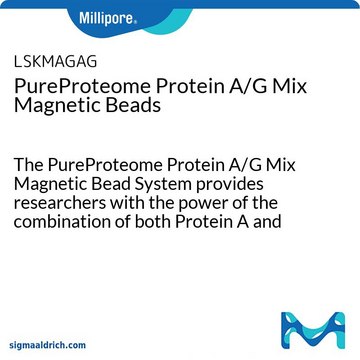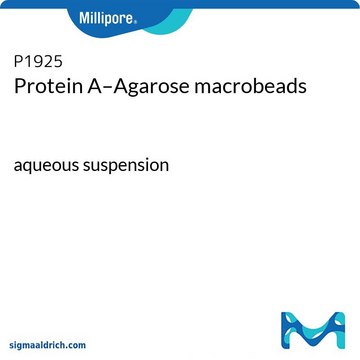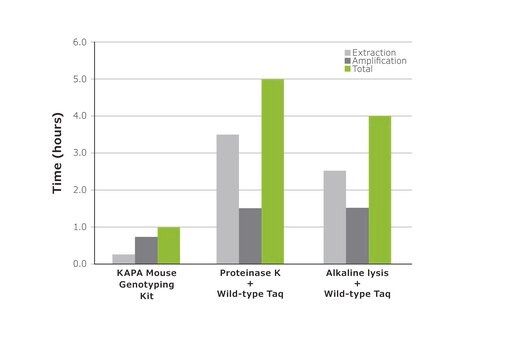PROTAA-RO
Roche
Protein A Agarose
>98% (HPLC and SDS-PAGE), suspension
Synonym(s):
agarose, protein a
Sign Into View Organizational & Contract Pricing
All Photos(1)
About This Item
UNSPSC Code:
41116133
Recommended Products
Assay
>98% (HPLC and SDS-PAGE)
form
suspension
packaging
pkg of 15 mL (05015979001 [settled resin volume])
pkg of 2 mL (11719408001 [settled resin volume])
pkg of 5 mL (11134515001 [settled resin volume])
manufacturer/tradename
Roche
capacity
>18 mg/mL binding capacity (human IgG (polyclonal))(the IgG is loaded at pH 7.4 and eluted with 200 mM glycine, pH 2.0)
storage temp.
2-8°C
General description
The use of recombinant Protein A in the production of Protein A agarose has the advantage that it is entirely free from Staphylococcal enterotoxins that are known to be mitogenic, and are contaminants in Protein A isolated from S. aureus. The immobilization chemistry provides high IgG-binding capacity and leak-proof stability under a wide range of pH and buffer conditions. The gel can be used over 30 times, depending on the elution condition.
Protein A leakage: <18 ng Protein A/ml (ELISA)
Regeneration: the gel can be used approximately 30 times
Structure: recombinant Protein A (E. coli, Mr = 45,000) is covalently coupled to crosslinked 6% agarose beads: 3 mg Protein A (>98% pure, HPLC, SDS-Page)/1 ml gel
Protein A, immobilized.
Protein A leakage: <18 ng Protein A/ml (ELISA)
Regeneration: the gel can be used approximately 30 times
Structure: recombinant Protein A (E. coli, Mr = 45,000) is covalently coupled to crosslinked 6% agarose beads: 3 mg Protein A (>98% pure, HPLC, SDS-Page)/1 ml gel
Protein A, immobilized.
Specificity
Protein A is a cell wall protein, isolated from a specific bacterial strain, which has specific binding sites for certain classes of immunoglobulins from different species. Protein A binds to varying degrees IgM, IgA, IgD, and most subclasses of IgG.
Application
Purification of mouse monoclonal antibodies from ascites fluid or cell culture supernatants. Protein A or Protein G Agarose affinity matrix can be used to purify antibodies from crude cell extracts and for the immunoprecipitation or co-immunoprecipitation of proteins. It has also been used for photoactivatable-ribonucleoside-enhanced cross-linking immunoprecipitation (PAR-CLIP) analysis.
Components
Preswollen gel, ready-to-use, 2 ml or 5 ml gel (settled gel volume) in buffer that contains 20% ethanol as a preservative, nonsterile.
Protein A content: 3 mg/ml pre-swollen gel
Protein A content: 3 mg/ml pre-swollen gel
Quality
Purity: >98% (HPLC, SDS-PAGE); entirely free from staphylococcal enterotoxins.
Other Notes
For life science research only. Not for use in diagnostic procedures.
Signal Word
Warning
Hazard Statements
Precautionary Statements
Hazard Classifications
Eye Irrit. 2 - Flam. Liq. 3
Storage Class Code
3 - Flammable liquids
WGK
WGK 1
Flash Point(F)
102.2 °F
Flash Point(C)
39 °C
Choose from one of the most recent versions:
Already Own This Product?
Find documentation for the products that you have recently purchased in the Document Library.
David Llobet-Navas et al.
Molecular and cellular biology, 34(23), 4216-4231 (2014-10-01)
Recently, we demonstrated that the microRNA 424(322)/503 [miR-424(322)/503] cluster is transcriptionally controlled by transforming growth factor β (TGF-β) in the mammary epithelium. Induction of this microRNA cluster impacts mammary epithelium fate by regulating apoptosis and insulin-like growth factor 1 (IGF1)
Hongbo Yang et al.
Developmental biology, 404(2), 49-60 (2015-05-26)
Angiogenesis relies on specialized endothelial tip cells to extend toward guidance cues in order to direct growing blood vessels. Although many of the signaling pathways that control this directional endothelial sprouting are well known, the specific cellular mechanisms that mediate
R Travis Taylor et al.
Methods (San Diego, Calif.), 55(2), 166-171 (2011-08-23)
Ubiquitin (Ub) conjugation to a substrate protein is a widely used cellular mechanism for control of protein stability and function, modulation of signal transduction pathways and antiviral responses. Identification and characterization of ubiquitinated viral proteins is an important step in
Ji-An Pan et al.
Molecular and cellular biology, 31(15), 3158-3170 (2011-06-02)
The accumulation of damaged or misfolded proteins, if unresolved, can lead to a detrimental consequence within cells termed proteotoxicity. Since cancerous cells often display elevated protein synthesis and by-product disposal, inhibition of the protein degradation pathways is an emerging approach
Daniel J Ryder et al.
PloS one, 10(8), e0136247-e0136247 (2015-08-25)
Skeletal muscle atrophy is a consequence of several physiological and pathophysiological conditions including muscle disuse, aging and diseases such as cancer and heart failure. In each of these conditions, the predominant mechanism contributing to the loss of skeletal muscle mass
Our team of scientists has experience in all areas of research including Life Science, Material Science, Chemical Synthesis, Chromatography, Analytical and many others.
Contact Technical Service










